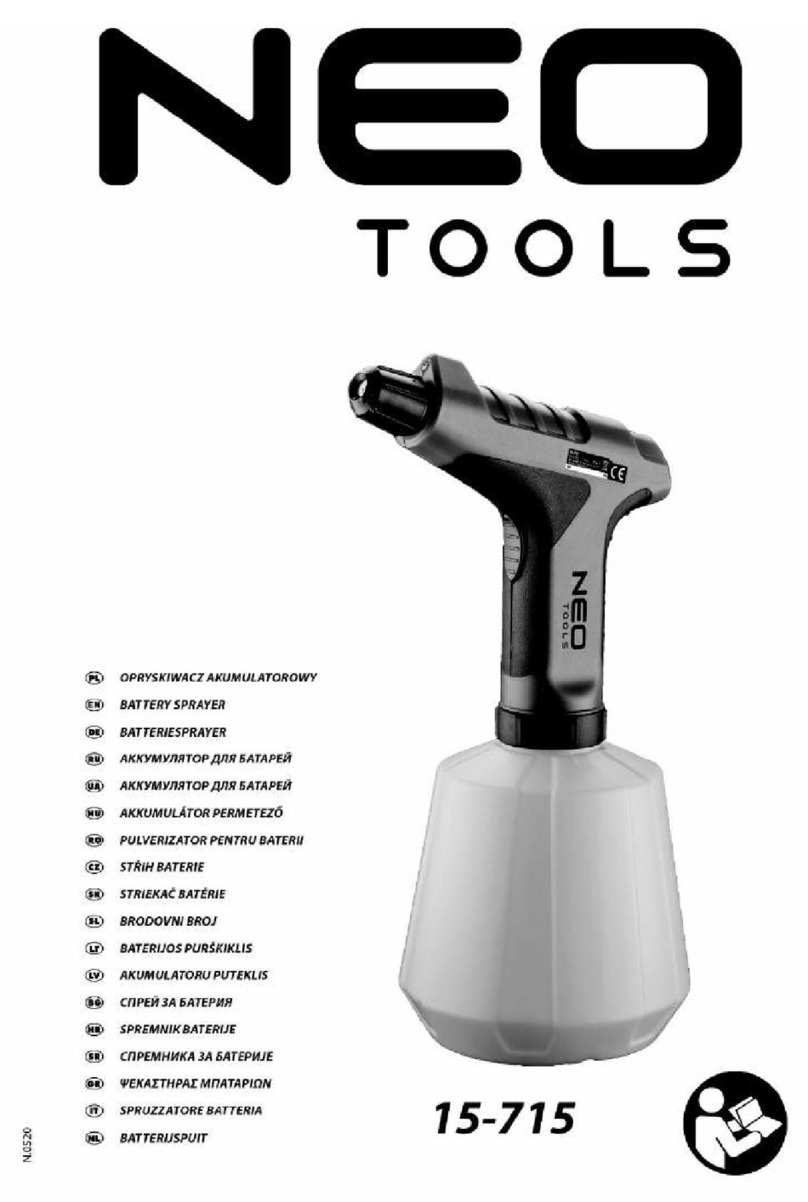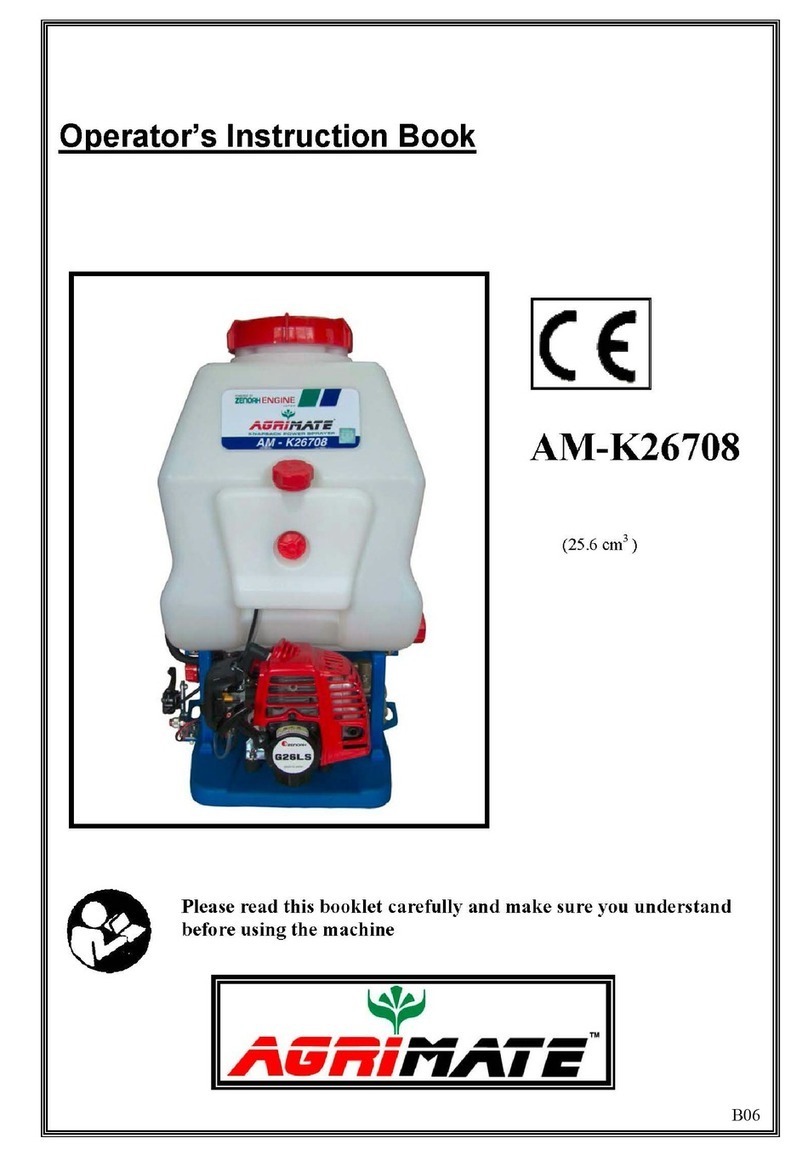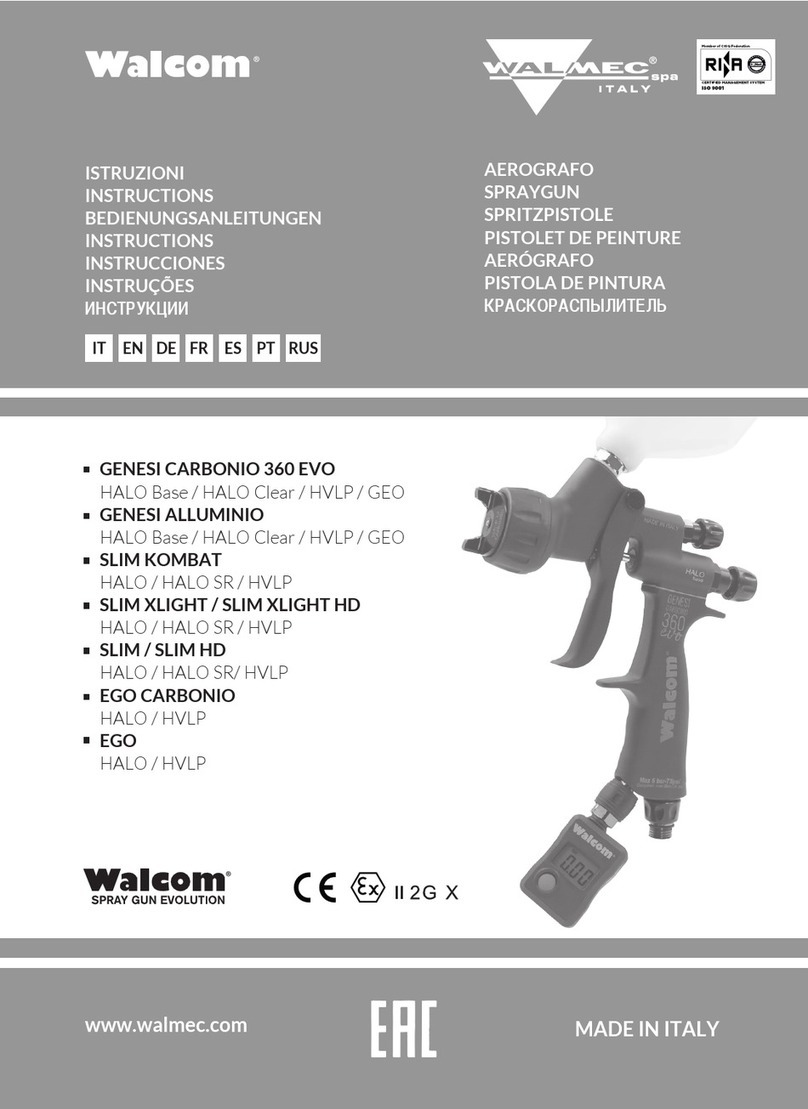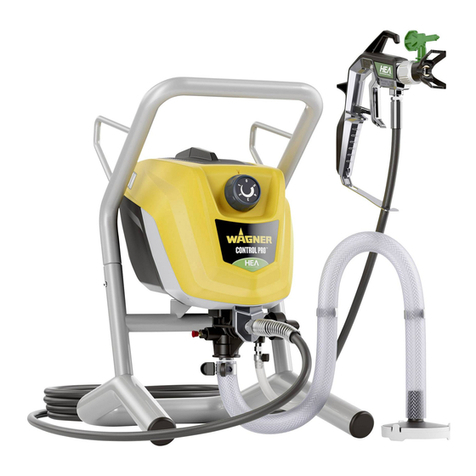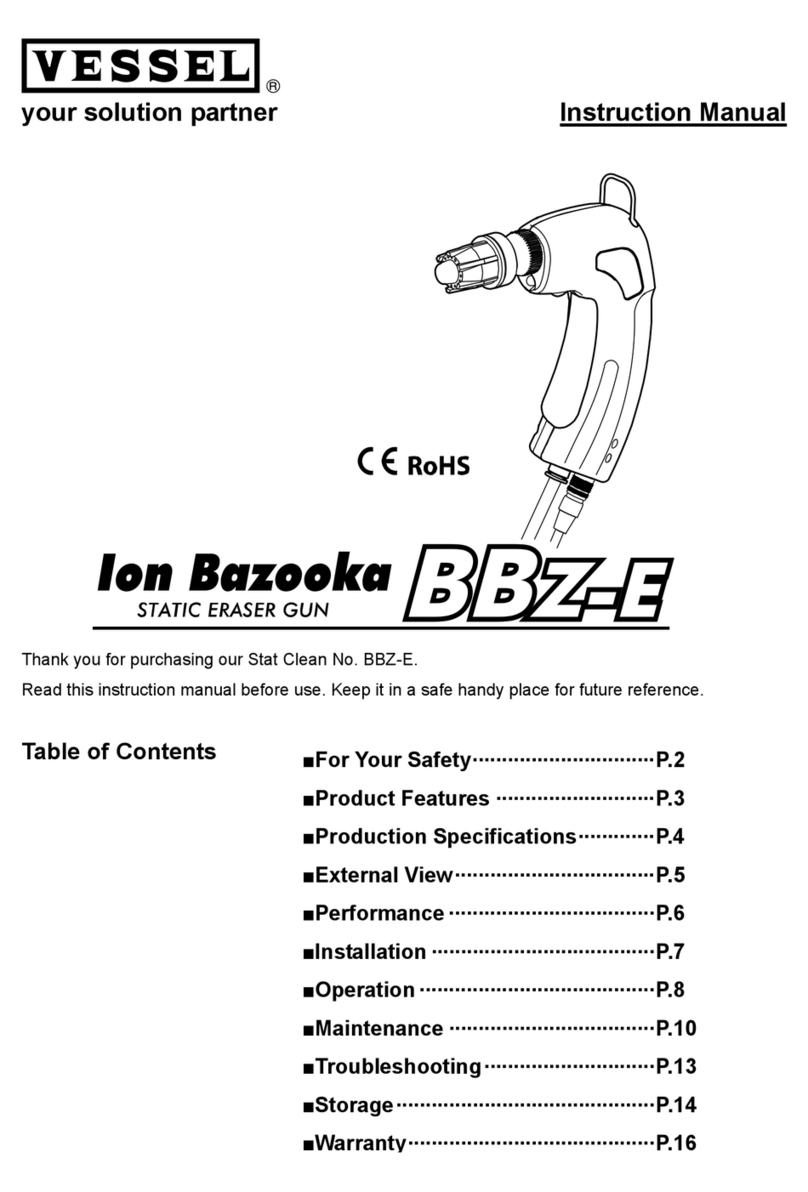Metrix HI-913 User manual

HI-913 HARDY SHAKER
Installaon Manual
DOC# 100929 • REV D (Jan 2018)
1. OVERVIEW
The Metrix Model HI-913 Portable Shaker
Table provides a eld-tested method
for on-the-spot dynamic vericaon of
accelerometers, velocity pickups and non-
contact displacement transducers. Oponal
mounng xtures and hardware needed to
connect transducers to the HI-913 mounng
plaorm are available upon request. A closed-
loop control algorithm provides enhanced
stability and accuracy of frequency and
amplitude levels.
The HI-913 incorporates a built-in sine wave
oscillator, power amplier, electrodynamic
shaker, NIST-traceable reference
accelerometer and digital display. The HI-913
is completely self-contained and operates on
baery or AC power.
The built-in reference accelerometer
is aached permanently to the shaker
armature, maximizing the accuracy between
the reference accelerometer and the test
transducer. The HI-913 is designed to provide
long-term reliable performance over the
frequency range of 7 Hz to 10 kHz. The HI-
913 can be used for a variety of applicaons
that include:
•Vericaon and calibraon of vibraon
transducers and related test systems
•Vericaon of connector and cabling
integrity
•Conrm machine vibraon alarm trip points
are set properly and ensure end-to-end
funconality of vibraon monitoring systems
Notes
•Loads of up to 800 grams (28.3 ounces) can
be mounted directly to the HI-913 mounng
plaorm. Larger loads may be applied to the
plaorm, however, if prolonged tesng of a
heavy load is planned, we recommend using
an external transducer suspension system.
Under these condions the vibraon wave-
form should be viewed on the oscilloscope
to aid in posioning the test transducer and
plaorm to reduce distoron that can occur
with very heavy weights.

Doc# 100929 • HI-913-Shaker • January 2018 - RevD Page 2 of 21
•The HI-913 should always be operated on a stable, at surface.
•The HI-913 is designed for eld test applicaons but care must be taken to maintain the
integrity of the mounng plaorm assembly.
•Hearing protecon recommended when operang the HI-913 for an extended amount of
me.
Accessories
Accessories pictured below are included with each HI-913 Portable Shaker Table.
Mounng Wrench 1-Mounng Pad
2-1/4-28 to 1/4-28 Adapter
3-10-32 to 1/4-28 Adapter
Power Supply and Plug Adaptors Acessory Pouch
A Cercate of Calibraon is also included
with every new unit. Metrix recommends
annual recalibraon of the HI-913 unit. The
factory service code for the recalibraon is
HI-913 CAL01.

Doc# 100929 • HI-913-Shaker • January 2018 - RevD Page 3 of 21
2. BASIC OPERATION
Test Set-Up
1. Mount your sensor to the HI-913 mounng plaorm.
• The HI-913 sensor mounng plaorm is threaded for a ¼-28 stud.
Select an appropriate adaptor for mounng the sensor.
• While ghtening the sensor, secure the HI-913 mounng plaorm
with the supplied wrench to prevent damage to the shaker from
torque.
2. Connect sensor signal condioner and readout device as necessary. Make sure
that connecons are secure.
3. Power the unit ON by pressing and holding the FREQUENCY dial for 3 seconds.
NOTE: It is good pracce to perform calibraons on baery power. Disconnecng
from line power ensures a power surge will not cause the calibrator to power down
during test. If excess current is detected during use, the portable calibrator shuts
down to prevent damage.
Seng the Frequency and Amplitude Units
1. Select the correct Frequency Units for your test by pressing the FREQUENCY dial
to enter into the CALIBRATION OPTIONS menu:
• Use the FREQUENCY dial to highlight TEST SETTINGS then press.
• Within the Test Sengs Menu rotate the FREQUENCY dial to highlight
FREQUENCY UNIT then press to toggle between Hertz and CPM.
2. Select the correct Amplitude Units for your test by pressing and releasing the
AMPLITUDE dial. The following opons are available:
Acceleraon Velocity Displacement
g’s pk
g’s RMS
m/s2 pk
m/s2 RMS
in/s pk
in/s RMS
mm/s pk
mm/s RMS
mils p-p
µm p-p
3. Select the desired vibraon amplitude and frequency for tesng by turning the
AMPLITUDE and FREQUENCY dials clockwise to increase or counter clockwise to
decrease the seng.
•Slow Turns – sengs will increase or decrease by single steps
•Fast Turns – sengs will increase or decrease by larger increments

Doc# 100929 • HI-913-Shaker • January 2018 - RevD Page 4 of 21
Compleng the Test
4. Verify that the level indicated on the HI-913 is the same as the level being shown
on the readout of the sensor under test.
5. Before powering the unit OFF, reduce the vibraon amplitude. The HI-913 retains
the sengs used prior to shutdown when it is powered back ON. Reducing the
amplitude prior to shutdown ensures the sensor under test will not be jarred when
the HI-913 is powered ON.
6. Power the unit OFF by pressing and holding the FREQUENCY dial for 3 seconds.
• To preserve baery charge, the HI-913 will automacally power o
aer 20 minutes of inacvity when not plugged into the charger.
Aer Tesng
7. Plug the HI-913 into an AC power source when not in use. This will ensure the
baeries are fully charged for your next test and will also help to maximize the
lifespan of the baeries.
8. Periodic calibraon checks are recommended.
• A dedicated “vericaon sensor” can be used to check the system
readings and results. By using a dedicated sensor, you can ensure that
the system is providing the same result during each test.
• The HI-913 should be returned to Metrix for regular recalibraon
(recommended annually) or for any maintenance or repair. The most
current factory recalibraon date is displayed on the LCD screen during
the HI-913 boot-up sequence.
Addional Features
Test Sengs
The “Test Sengs” menu can be found by pressing FREQUENCY dial > “Test
Sengs.” A screen with the following will appear, use the FREQUENCY dial to
highlight and toggle all sengs:
• Back – returns user to “Calibraon Opons” menu
• Cal Route: N/A, Acve or o
o N/A indicates the Calibraon Route rmware opon has
not been purchased. Calibraon Route allows users to
program semi-automated test points. See “Calibraon
Route” secon for more informaon. Contact Metrix to
unlock this feature.
• Source: Internal or External
o If external is selected the shaker can be controlled
with an external source. See “Input/Output” for more
informaon.

Doc# 100929 • HI-913-Shaker • January 2018 - RevD Page 5 of 21
• Frequency Unit: Hertz or CPM (cycles per minute)
Amplitude Units
• Amplitude units that are seldom or never used can be turned
o by using the “Amplitude Units” feature, found by pressing
FREQUENCY dial > “Amplitude Units.”
• The “Amplitude Unit Screen” shows all 10 available amplitude
scales on model HI-913 Portable Vibraon Calibrator. Use the
FREQUENCY dial to highlight each scale and press the dial
to toggle the scale on or o. A lled circle next to the scale
indicates it is acve. An empty circle next to the scale indicates
it is inacve. Inacve scales do not appear when cycling through
scales using the AMPLITUDE dial during normal operaon.
• To go back to the “Calibraon Opons” menu use the
FREQUENCY dial to highlight “Back” then press.
Extending Low Frequency Operaon to 5 Hz
Firmware Opon: HI-913-LF5
Model HI-913 must be ordered with rmware oponHI-913-LF5 for the low
frequency response to be extended from 7 Hz to 5 Hz (420 CPM to 300 CPM). This
rmware can be added at any me. Contact Metrix for ordering and installaon
informaon.
The operaon of model HI-913 does not change if the HI-913-LF5 opon is
ordered. The minimum low frequency response will be 5 Hz instead of 7 Hz. Allow
for extra me for the shaker and sensor under test to sele when tesng at slow
speeds. The HI-913 has a pre-compensaon algorithm to reduce distoron. At
speeds below 10 Hz this algorithm takes 1-5 seconds to center vibraon on the
fundamental frequency and reach the desired amplitude.
Denion of Frequency Units
• Hertz (Hz) is dened as the number of periodic cycles per second and
it is a standard unit for measuring signal frequency.

Doc# 100929 • HI-913-Shaker • January 2018 - RevD Page 6 of 21
• CPM stands for Cycles Per Minute. CPM is commonly used for tesng
industrial sensors that monitor rotaonal vibraon. 1 Hz=60 CPM
Amplitude Basics
• Root Mean Square (RMS) is a calculaon that takes the square root of
the average of the squared amplitudes from a set of data. This type of
measurement takes all amplitudes of a signal into account rather than
just one, making it an accurate tool for an overall calculaon.
• Peak (pk) bases calculaons on the highest value of the signal
generated during tesng. For a sinusoidal wave (as is produced by
the HI-913), the peak value is calculated by RMS*√2. The HI-913
does not measure a true peak value, but instead esmates the value
mathemacally based upon the RMS value.
• Peak-to-Peak (p-p) is a calculaon of the dierence between the
highest posive peak and the lowest negave peak of a recorded sine
wave. The
p-p value is calculated as two mes the peak value.
• Gravitaonal acceleraon (g) is the acceleraon experienced naturally
by objects in earth’s gravitaonal eld. It is approximately equal to
9.80665 m/s2.
Mounng Basics
Connecng Sensor to HI-913 Plaorm
1. Mang surfaces of the mounng plaorm and sensor should be at,
parallel and free of dirt, paint, epoxy, scratches, etc.
2. Threads in plaorm, sensor and adaptor (if needed) must match to
ensure a proper t and that tesng is free of errors. Clean any worn
threads with a tap or die and coat them in a silicone grease for best
results.
3. An adaptor may be needed to connect the sensor to the armature.
The HI-913 plaorm requires a ¼-28 thread.
Figure: Sinusoidal Wave

Doc# 100929 • HI-913-Shaker • January 2018 - RevD Page 7 of 21
4. Silicone grease can be applied to the mang surfaces and threads to
ensure good mechanical coupling. This is parcularly important when
tesng at high frequencies.
5. For threaded sensors, please follow the sensor manufacturer’s torque
recommendaon.
Tightening and Loosening Connecons
1. When ghtening or loosening the connecon between the sensor
and the HI-913 mounng plaorm, secure the mounng plaorm
with the supplied wrench.
2. It is important to keep sensors and xtures centered and straight
when aaching them to the HI-913 mounng plaorm. This will
ensure a stable, even connecon and eliminate potenal alignment
issues.
External Source Input
As an opon, it is possible to drive the HI-913 by using an external signal source
or a funcon generator. First, connect a signal source to the External Source
BNC Input located on the top right corner of the unit. To enable the EXTERNAL
SOURCE IN input, press the FREQUENCY dial to enter the “Calibraon Opons”
menu then rotate FREQUENCY dial to highlight and click on TEST SETTINGS. Next,
use FREQUENCY dial to highlight selecon next to “Source:” and toggle between
“Internal” and “External” by pressing the dial, select “External”.
1.When in external signal mode, the vibraon amplitude is
measured and displayed on the screen, however, the frequency
and amplitude of the shaker is controlled by the external source,
not by the HI-913. The frequency of the input signal is not
displayed on this mode.
2. The amplitude and sensivity values displayed on the screen are
for reference only. The measurements are not accurate while in
Ext Sig mode and do not fall under the published specicaons
for the product.
Do not exceed 1V RMS! Overdriving the unit may cause clipping,
unwanted distoron and damage to the unit.
Monitor Reference Output
The HI-913 is controlled by an internal shear mode quartz reference accelerometer.
The voltage output of the reference accelerometer can be monitored through the
available Monitor Reference BNC Output by connecng it to a readout device (e.g.
voltmeter or oscilloscope).
USB Connecon
The USB connecon for model HI-913 has no funconality unless power supply
accessories like HI-913-PS02 24 VDC power supply or HI-913-CALROUTE is ordered.
It is used at Metrix, Inc. during the manufacturing and calibraon processes.

Doc# 100929 • HI-913-Shaker • January 2018 - RevD Page 8 of 21
3. THEORY OF OPERATION
Instrumentaon
The Model HI-913 Portable Shaker Table internal electrical system is comprised of
several dierent mechanisms:
• Electrodynamic Shaker
• Power Amplier
• Reference Accelerometer
• Signal Generaon Electronics
• Sensor Signal Measurement Electronics
• LCD Digital Display
• Two Dials with Detent and Integrated Push Buons
• 12 VDC, 4 Amp Hour Solid Gel Baery
• External Charger
The LCD display connuously shows the frequency of the shaker drive signal and
the vibraon amplitude of the mounng plaorm as measured by the reference
accelerometer.
The reference accelerometer is a PCB Piezotronics ICP® quartz shear sensor,
integrated into the mounng plaorm. A calibraon “standard” maintained by
Metrix is used to calibrate the HI-913 as a complete system and provides NIST
traceability.
The power amplier is specially designed to provide the current required to drive
the electrodynamic shaker.

Doc# 100929 • HI-913-Shaker • January 2018 - RevD Page 9 of 21
The electronic signal processing system produces a variable frequency sine wave,
which becomes the source of the driving signal to produce the vibraon at the
mounng plaorm.
The frequency of the shaker drive signal is controlled by the front panel
FREQUENCY dial. The amplitude of the shaker drive signal is controlled through a
feedback loop, to maintain the stability of the actual moon. Adjusng the front
panel AMPLITUDE dial adjusts the target vibraon amplitude.
Pressing the FREQUENCY dial toggles the frequency units between CPM and Hz.
Pressing the FREQUENCY dial one more me enables the External Source Input.
Pressing the AMPLITUDE dial toggles the amplitude measurement units through
the following choices:
Frequency Acceleraon Velocity Displacement
Hz
CPM
External Signal
g’s pk
g’s RMS
m/s2 pk
m/s2 RMS
in/s pk
in/s RMS
mm/s pk
mm/s RMS
mils p-p
µm p-p
3.2 Baery and Charger
The Model HI-913 can be operated from AC line power or from its internal
rechargeable baery. When the external power supply is connected, it becomes
the primary power source, operang the unit while simultaneously charging the
baery.
NOTE: It is good pracce to perform calibraons on baery power. Disconnecng
from line power ensures a power surge will not cause the calibrator to power down
during test. If excess current is detected during use, the portable calibrator shuts
down to prevent damage.
Baery power is supplied by a sealed solid gel lead acid 12 VDC rechargeable
baery. The baery can be permanently damaged if completely drained. To
prevent damage, the HI-913 will automacally shut o when the baery power
level gets too low. Keeping the baery fully charged ensures the unit is always
ready for use.
Under mild operang condions, a fully charged baery will allow the HI-913 to
operate for up to 18 hours. The charge life of the baery depends on both the
length of use and the amount of power (dependent upon payload, frequency and
amplitude) required for a parcular test. When tesng requires high vibraon
levels, the charge life will be shorter than during less rigorous tesng. For example,
connuous tesng of a 100 gram payload at 10 g pk will drain the baery charge in
approximately 1 hour.
A “Baery Life” indicator is displayed on the LCD screen to approximate the unit’s
remaining charge life. Replacement baeries (Model HI-913 BAT01) and power
supplies/chargers (Model HI-913-PS01) are available from Metrix, Inc.

Doc# 100929 • HI-913-Shaker • January 2018 - RevD Page 10 of 21
The HI-913 calibrators connuously monitor the state of baery charge during
operaon, storage and charging. During operaon, if the baery capacity falls
near minimum, the unit will shut o aer approximately 2 minutes of inacvity
rather than the usual 20 minutes. During storage, if the baery voltage falls near
the minimum, the unit will go into deep sleep, requiring connecon of AC power
and reset of me and date before resumpon of operaon. During charging, the
unit connuously displays charging indicaon and state of charge, depending upon
operaon level and me of charge.
When operang the HI-913 at high amplitudes and heavy payloads
with the baery charger plugged in, the current draw to the shaker
and amplier can be large enough to overload the charging circuit
resulng in an unstable output signal. Operang the HI-913 under
these condions can result in damage to the electrical components in
the system. In order to re-establish a stable output signal, turn down
the amplitude level of the HI-913 or unplug the charger.
Baery Informaon and Care
• The unit is delivered in a parally charged state. Fully charge unit for 20 hours
before using for the rst me. (The unit cannot be overcharged by keeping it
plugged into the power supply.)
• To recharge the unit, use only the universal power supply included. All
baeries lose energy from self-discharge over me and more rapidly at higher
temperatures. A full charge cycle can take up to 20 hours.
• If not used for a prolonged period of me, recharge every 2 months.
• Suggested Best Pracce: Charge unit fully prior to eld use. Recharge the unit
as soon as possible aer use.
4. SPECIFICATIONS AND PERFORMANCE
General
Frequency Range
(operang, 100 gram
payload)
7 Hz - 10 kHz 420 - 600 k CPM
Maximum Amplitude
(100 Hz no payload)
20 g pk
15 in/s pk
50 mils pk-pk
196 m/s2 pk
380mm/s pk
1270 µm pk - pk
Maximum Payload[1] 800 gram 800 gram
[1] Operang range reduced at higher payloads. Reference manual for full details

Doc# 100929 • HI-913-Shaker • January 2018 - RevD Page 11 of 21
Accuracy of Readout
MEASURED WITH 10 GRAM QUARTZ REFERENCE ACCELEROMETER
Acceleraon (30 Hz to 2 kHz) ± 3%
Acceleraon (7 Hz to 10 kHz) ±1 dB
Velocity (10 Hz to 1000 Hz) ± 3%
Displacement (30 Hz to 150 Hz) ± 3%
Amplitude Linearity (100 gram
payload, 100 Hz)
< 1% up to 10 g pk
Waveform Distoron (100 gram
payload, 30 Hz to 2 kHz)
< 5% THD (typical) up to 5 g pk
Units of Readout
Amplitude
Acceleraon g pk m/s2 pk
g RMS m/s2 RMS
Velocity in/s pk mm/s pk
in/s RMS mm/s RMS
Displacement mils pk-pk µm pk - pk
Frequency Hz CPM
Power Requirements
Internal Baery
(sealed solid gel lead
acid)
12 VDC, 4 amp hours 12 VDC, 4 amp hours
AC Power
(for recharging baery)
110 – 240 Volts,
50 - 60 Hz
110 – 240 Volts,
50 - 60 Hz
Operang Baery Life[2]
100 gram payload, 100
Hz, 1 g pk
18 hours
100 gram payload, 100
Hz, 10 g pk
1 hour
[2] As shipped from factory in new condion
Temperature
Operang 32° - 122 °F 0° - 50 °C
Physical
Dimensions (H x W x D) 8.5 in x 12 in x 10 in 22 cm x 30.5 cm x 28 cm
Weight 18 pounds 8.2 kg
Sensor Mounng
Plaorm Thread Size
¼ - 28

Doc# 100929 • HI-913-Shaker • January 2018 - RevD Page 12 of 21
Shaker Loading
Maximum advisable vibraon levels are dependent upon the maximum frequency
of operaon and the payload. The chart below shows the maximum vibraon
levels as a funcon of both frequency and payloads. Payloads exceeding 800 grams
should not be tested on the Model HI-913.
Excessive loads may result in damage to the moving coil and exure. Care must be
taken when tesng payloads with large footprints, parcularly those with an oset
center of gravity. Severe rocking modes can produce high transverse moon and
lateral loads on the moving coil and exure, resulng in damage. When ng test
transducers and xtures onto the mounng plaorm, aim to keep the center of
gravity directly above, and in line with the center axis of the ¼-28 threaded hole.
This is a safeguard against side loading the shaker.
In some cases of extremely heavy shaker payloads at high vibraon levels
(depending on the frequency), the HI-913 may exhibit both frequency and
amplitude instabilies. In this case, please reduce the excitaon amplitude and/or
the payload to eliminate the eect.
The HI-913 electronics incorporates a shaker power amplier with thermal
protecon. If the shaker payload amplitude and run me exceed safe thermal
ranges, the shaker table power amplier will protect itself and shut o. The unit
should be turned o and allowed to cool before resuming operaon.

Doc# 100929 • HI-913-Shaker • January 2018 - RevD Page 13 of 21

Doc# 100929 • HI-913-Shaker • January 2018 - RevD Page 14 of 21
5. RECOMMENDED PRACTICES
Operaonal Vericaon and Recalibraon
As with all calibraon systems, periodic vericaon of the system’s performance
is strongly recommended. This is best done by calibrang a dedicated vericaon
accelerometer each day that the unit will be used. This pracce conrms proper
calibraon of the equipment at the me of use.
Results of the vericaon should be compared to previous results obtained with
that dedicated, controlled accelerometer. If the calibraon result of the vericaon
sensor changes, the HI-913 should be evaluated further to determine the root
cause of the discrepancy.
Field repair of the HI-913 is not possible, so if performance of the HI-913
is out of specicaon, it should be sent back to Metrix, Inc. for evaluaon,
repair and recalibraon. Please contact Metrix at info@metrixvibraon.com or
+1.281.940.1802 for a Return of Material Authorizaon (RMA) number.
Standard Checks for Transducers
Linearity and frequency response checks should be performed periodically to
validate vibraon transducer funconality.
Linearity is checked by subming the sensor to dierent vibraon levels while
frequency is kept constant (typically at 100 Hz or any other frequency specied
by the transducer’s manufacturer). The vibraon is set to dierent levels within
the dynamic range of the sensor, trying to cover (as much as possible) from low
to high operang levels. The sensor output is recorded and checked if it remains
proporonal (linear) to the sensor excitaon input. Alternavely, the sensor
sensivity can also be recorded and its deviaon observed for the dierent test
points (it should not vary too much for sensors that are linear).
The frequency response of a vibraon transducer can be tested by checking the
sensor output across dierent frequency points within the operaonal frequency
range of the transducer. Typically, the vibraon level of the unit is set at a constant
value (10m/s² and 1g are common choices for accelerometers) and the sensor
output (or the sensor sensivity) is observed and recorded at dierent frequency
points.
Typical Accelerometer & Velocity Sensor Checkout
Accelerometers & velocity sensors are tested by performing a frequency response
calibraon. This is done by measuring the sensivity of the sensor at a variety of
frequencies within its linear range. Per the ISO 16063-21 accelerometer calibraon
standard, the amplitude at each frequency is at the discreon of the user and need
not be kept consistent. Best pracce is to use amplitude safely above the noise
oor and but low enough not to create distoron on the shaker. Thus 1.0 g’s peak is
the most common aplitude for accelerometers.
The ISO 16063-21 standard recommends tesng at the center frequencies of the
1/3 octave bands. For accelerometers with 10 kHz high frequency response that
would mean 29 dierent test points, which can be me consuming. Accelerometer
manufacturers test at far less points. In general as long as the test covers the
praccal usage of the sensor and the test points are evenly dispersed through the

Doc# 100929 • HI-913-Shaker • January 2018 - RevD Page 15 of 21
test range the user will perform a good and thorough test of an accelerometer.
A good pracce within industrial applicaons is to follow the American Petroleum
Instute Standard 670 “Machinery Protecon Systems” recommendaons for
accelerometer and velocity sensor test points. Standard 670 recommends tesng at
the following frequencies for both accelerometers and velocity sensors:
• 10, 20, 50, 60, 100, 200, 500, 1000, 2000, 5000 and 10000 Hz
o Model HI-913 is not capable of 61.44 Hz, only
integer numbers such as 61 or 62.
For accelerometers the recommended amplitudes in API 670 are:
• 0.15 g’s peak (1 m/sec2 RMS) for 10 Hz
• 1 g peak (7 m/sec2 RMS) for 20-1000 Hz
• 4 g’s peak (30 m/sec2 RMS) for 2000-10000 Hz
For velocity sensors the recommended amplitudes in API 670 are:
• 0.92 ips peak (15.92 mm/sec RMS) for 10 Hz
• 3.08 ips peak (55.70 mm/sec RMS) for 20 Hz
• 1.23 ips peak (22.28 mm/sec RMS) for 50 Hz
• 0.62 ips peak (11.14 mm/sec RMS) for 100 Hz
• 0.31 ips peak (5.57 mm/sec RMS) for 200 Hz
• 0.12 ips peak (2.23 mm/sec RMS) for 500 Hz
• 0.06 ips peak (1.11 mm/sec RMS) for 1000 Hz
• 0.12 ips peak (2.39 mm/sec RMS) for 2000 Hz
• 0.05 ips peak (0.95 mm/sec RMS) for 5000 Hz
• 0.02 ips peak (0.48 mm/sec RMS) for 1000 Hz
o Note that velocity is not recommended as a vibraon
measurement scale at frequencies greater than 1000
Hz. Thus many sensor manufacturers install low-pass
lters on velocity sensors at 1000 Hz or lower.
Praccal Industrial (Predicve Maintenance) Tesng Recommendaons
While tesng to the API 670 or ISO 16063-21 standard is certainly thorough it is not
always praccal and is me consuming especially for the predicve maintenance
user. Thus Metrix makes the following recommendaons for industrial vibraon:
• For permanent mount accelerometers/velocity sensors routed
to an online monitoring system or juncon box, at least test
the sensors at 1x and 2x running speed and conrm both the
vibraon alert (high) and alarm (high-high).
• For route-based predicve maintenance where one sensor
is magnecally mounted on many machines at many
points, perform a complete frequency response test of the
accelerometer. Its accuracy is important at many frequencies.
Test to Fmax on the vibraon analyzer. If high frequency bearing

Doc# 100929 • HI-913-Shaker • January 2018 - RevD Page 16 of 21
fault detecon methodologies are in use, test the sensor to the
highest possible bearing defect frequency.
o Tip: magnecally mounng sensors greatly reduces high
frequency response. A ferrous magnet target, mounng
pad, is included with the HI-913. One can install this pad
on the shaker and mount accelerometers magnecally.
Always rock the sensor in place as one would on the
machine. Test the accelerometer to Fmax on the
analyzer to see if response is amplied at relevant high
frequencies.
5.3 Non-Contact Displacement Sensor Calibraon
Non-contact displacement sensors, also known as proximity probes, eddy current
probes or simply displacement probes, can be checked for accuracy, linearity and
frequency response. Proximity probe systems require the use of the oponal
proximity probe adaptor kit, shown on the next page. The following secons detail
the procedure for performing linearity and frequency response checks on a non-
contact displacement sensor.
Non-Contact Displacement Sensor Test Set-Up
Note: The calculaons in these instrucons are based on a 200 mV/mil eddy current
proximity probe to provide an example based on nominal sensivity. In most cases,
the proper proximity probe, extension cable, and driver (proximitor®) must be
matched in order to obtain the expected output from this type of transducer.
[Proximitor is a registered trademark of Bently Nevada.]

Doc# 100929 • HI-913-Shaker • January 2018 - RevD Page 17 of 21
1. Remove the (2) 10-32 pan head screws on the user panel of the
portable shaker table (white arrows in picture below).
2. Install the AISI 4140 steel target into the shaker on the mounng
plaorm.

Doc# 100929 • HI-913-Shaker • January 2018 - RevD Page 18 of 21
3. Install the non-contact displacement sensor in the microarm aer
stringing the probe through the probe bar as shown in the picture
below. Please note: An 8 mm non-contact displacement sensor
with 3/8 - 24 threaded case will mount directly while a 5 mm non-
contact displacement sensor with a ¼ - 28 threaded case requires the
supplied bushing. Slide the non-contact displacement sensor into the
microarm; ghten the socket head cap screw inside the microarm to
lightly squeeze the probe to ensure the probe is held securely.
Carefully lay out the assembly to resolve the required spacer or spacers to hold the
non-contact displacement sensor the proper distance from the target as shown
below. The non-contact displacement sensor will need to be held so that the
sensor will contact the target and must be capable of traveling 100 mils before
the micrometer runs out of travel. (for 200 mV/mil probe with 10-90 mils range).
Non-contact displacement sensors come in various lengths so adjustability has
been designed into the assembly. Aach selected spacer or spacers using setscrews
provided, leaving threaded holes exposed.
Socket Head
Cap Screw Set Screw

Doc# 100929 • HI-913-Shaker • January 2018 - RevD Page 19 of 21
4.Finalize the assembly by aaching probe bar, microarm, non-contact
displacement sensor, and micrometer on top of the spacers and
secure with provided panel screws.

Doc# 100929 • HI-913-Shaker • January 2018 - RevD Page 20 of 21
Proximity Probe Dynamic Linearity Calibraon & Conrmaon of Vibraon
Alarms
IMPORTANT: The HI-913 powers up at the unit’s previous frequency and amplitude
sengs. Prior to using the HI-913 for calibrang non-contact displacement
sensors, set amplitude to a low level to avoid striking the p of the probe with the
target due to previously set large displacements.
1. Mount the proximity probe to the shaker facing the target by following
instrucons in the previous secon.
2. Gap the probe. With the non-contact displacement sensor powered
up and the output from the probe driver wired to a voltmeter set
to DC voltage, adjust the micrometer so the gap between the probe
p and the steel target is around 50 mils. If you are using a 200 mV/
mil proximity probe the voltmeter should read between -8 and -11
Volts DC, typically ~-9 Volts DC is 50 mils. Fiy mils is the typical
recommended gap seng for non-contact displacement sensors,
ensuring the sensor is in the center of its dynamic range. If the probe
is 50 mils from target (or rotang equipment before start-up) it can
accurately measure up to 80 mils peak-to-peak vibraon. Consult
your non-contact displacement sensor’s user manual for addional
informaon.
3. Power-on the shaker by pressing and holding the FREQUENCY dial.
4. Test the probe at running speed of the machinery it protects.
Primary vibraon issues occur at running speed. Thus ensuring the
proximity probe is accurate at running speed is the most praccal
and condence-building test. Test speed can be set in Hz or CPM
(see Secon 2: Operaon Guide for instrucons) by turning the
FREQUENCY dial.
5. Conrm vibraon alarms. Press the AMPLITUDE dial to cycle through
vibraon scales unl either mils p-p or µm p-p is displayed. Choose
the appropriate scale for your vibraon monitoring system. Turn the
AMPLITUDE dial, adjusng vibraon to the lowest vibraon alarm
threshold (somemes called “alert”). Conrm with control room that
displayed amplitude on model HI-913 shaker equals value read on
monitoring system. Conrm vibraon alarm is triggered, making sure
to wait long enough for programmed me delays to expire. Repeat the
process for each vibraon alarm threshold.
Troubleshoong the proximity probe system
If the vibraon alarms did not acvate at desired vibraon thresholds the most
common reason when using proximity probes is incorrect cabling. Advice on
troubleshoong follows below. Be sure to read the previous secon on conrming
vibraon alarms by dynamic linearity tesng.
• Connect the output of the probe driver to a volt meter measuring AC
voltage.
• The volt meter measures in AC voltage RMS. The HI-913 simulates
displacement vibraon in peak-to-peak scale. Thus one must convert
the RMS voltage measurement to peak-to-peak. To do so mulply the
measurement on the volt meter by 2.828.
o Example: when shaking target at 5 mils peak-to-peak and
3600 CPM, volt meter measures 353 mV AC. Mulply this
number by 2.828 to get 998 mV (353 mV x 2.828 = 998 mV).
Proceed to next step.
Table of contents
Popular Paint Sprayer manuals by other brands

WAGNER
WAGNER GM 4700AC operating manual
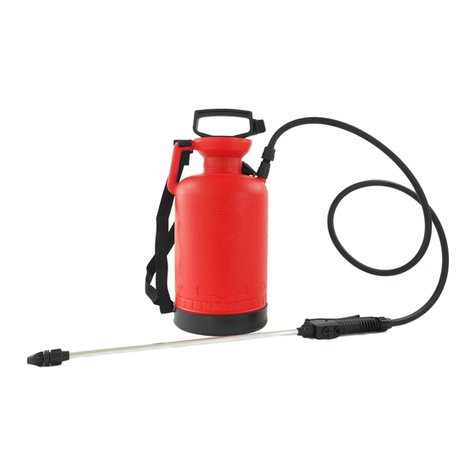
DAL DEGAN
DAL DEGAN ARES 6 Instructions for the use
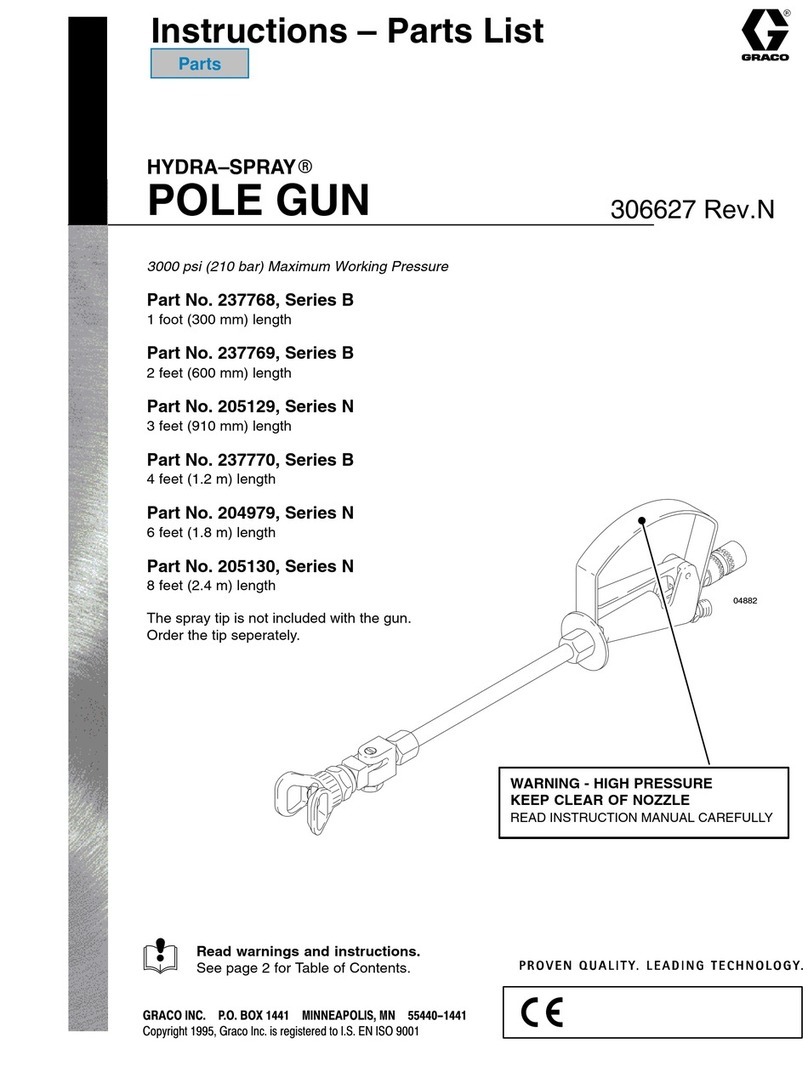
Graco
Graco HYDRA-SPRAY N Series Instructions-parts list
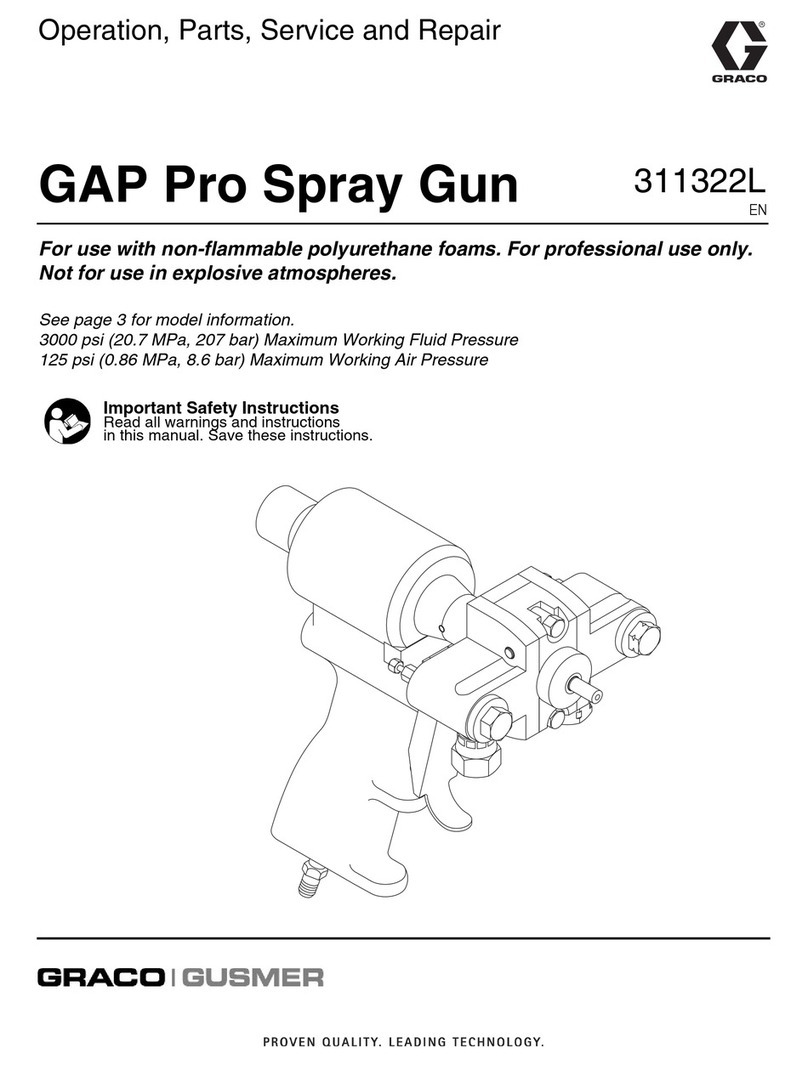
Graco
Graco 311322L Operation, parts, service and repair
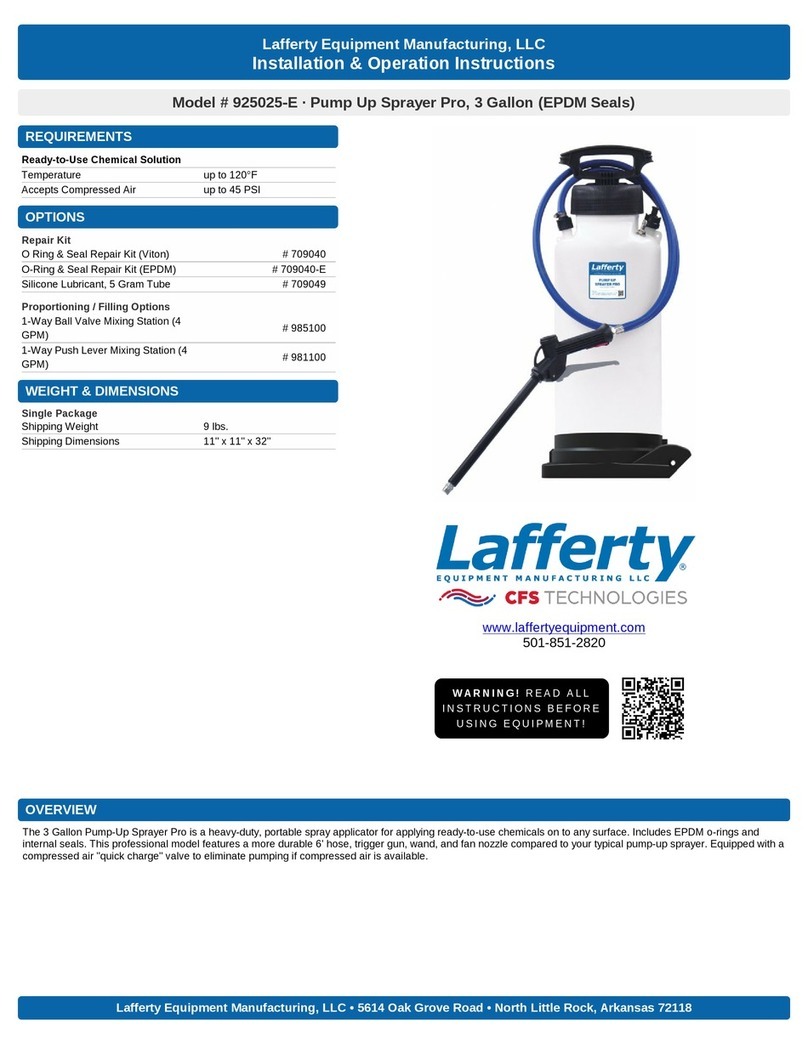
Lafferty
Lafferty 925025-E Installation & operation instructions

KISANKRAFT
KISANKRAFT FarmBoy FB-KPS-204/804 user manual



